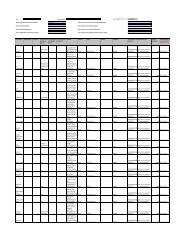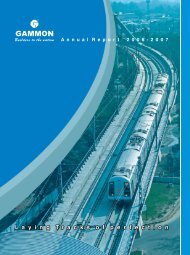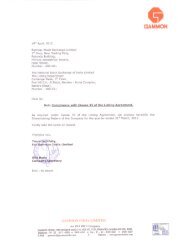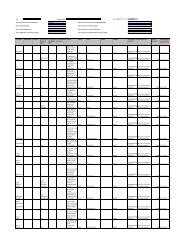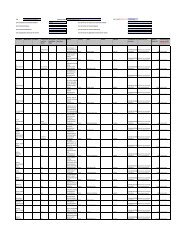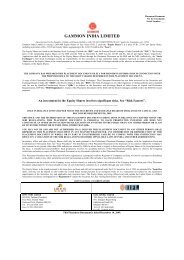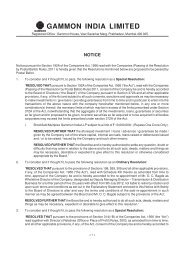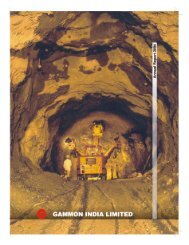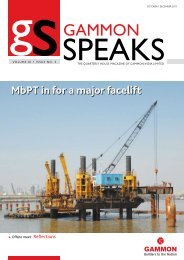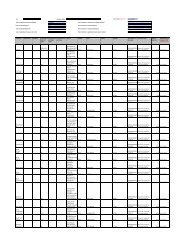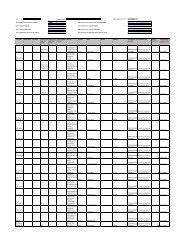Annual Report 2010-2011 - Gammon India
Annual Report 2010-2011 - Gammon India
Annual Report 2010-2011 - Gammon India
You also want an ePaper? Increase the reach of your titles
YUMPU automatically turns print PDFs into web optimized ePapers that Google loves.
10. Investments<br />
Investments are classified as current and long term investments. Investments that are readily realisable and intended to be held for not more<br />
than a year are classified as current investments. All other investments are classified as long-term investments. Current investments are carried<br />
at lower of cost and fair value determined on an individual investment basis. Long-term investments are carried at cost. However, provision for<br />
diminution in value is made to recognise a decline other than temporary in the value of long term investments.<br />
Investments in associates are accounted under Equity Method as per Accounting Standard-23 “Accounting for Investments in Associates in<br />
Consolidated Financial Statements” issued by Institute of Chartered Accountants of <strong>India</strong> (‘AS 23’).<br />
11. Inventories<br />
(i) In case of the <strong>India</strong>n Operations, the Stores and Construction Materials are valued and stated at lower of cost or net realisable value. The<br />
FIFO method of inventory valuation is used to determine the cost. Raw materials are valued at cost, net of Excise duty and Value Added<br />
Tax, wherever applicable. Stores and spares, loose tools are valued at cost except unserviceable and obsolete items that are valued at<br />
estimated realizable value thereof. Costs are determined on FIFO method.<br />
(ii) Work-in-progress on construction contracts reflects value of material inputs and expenses incurred on contracts including estimated profit<br />
in evaluated jobs.<br />
(iii) Work in progress from manufacturing operation is valued at cost and costs are determined on FIFO method.<br />
(iv) Finished goods are valued at cost or net realizable value, whichever is lower. Costs are determined on FIFO method except in case of<br />
overseas operations and an <strong>India</strong>n subsidiary where the Finished goods are valued on Weighted Average Cost basis.<br />
(v) In case of the overseas Operations and an <strong>India</strong>n subsidiary, the Stores & spares and Construction materials are valued at Weighted<br />
Average Cost basis.<br />
(vi) Works in progress for service contracts are measured based on the status of completion of work. Whenever the results of the agreement<br />
cannot be reliably evaluated, revenues are recognized only to the extent that costs are deemed to be recoverable. The costs for purchasing<br />
goods and services are recognized in the income statement on accrual basis and develop into decreases in economic benefits, which occur<br />
in the form of cash outflows, or of impairment of assets or incurring liabilities.<br />
12. Foreign Currency Translation<br />
Initial Recognition<br />
Transactions in foreign currencies are recorded at the exchange rate prevailing on the date of transactions. Fixed Assets acquired in foreign<br />
currencies are translated at the rate prevailing on the date of Bill of Lading.<br />
Conversion<br />
Current Assets and Current Liabilities are translated at the year end rate or forward contract rate.<br />
Exchange Differences<br />
(a) Any Gain or Loss on account of exchange difference either on settlement or translation is recognized in the Profit and Loss Account.<br />
(b) The exchange gain/loss on long term loans to non integral operations being subsidiaries are restated to Foreign Exchange Translation<br />
Reserve Account and will be transferred to the Profit & Loss Account in the year when the disposal of or otherwise transfer of the operations<br />
are done.<br />
Translation<br />
(a) The transactions of Oman branch are accounted as a non-integral operation. The related exchange difference on conversion is accounted<br />
under Foreign Currency Translation Reserve Account.<br />
(b) The transactions of branches at Kenya, Nigeria, Bhutan and Algeria are accounted as integral operation.<br />
(c) The conversion of component financial statements expressed in foreign currency are as follows:<br />
– the assets and liabilities are converted using the exchange rates in effect as of the Balance Sheet date;<br />
– the income and expenditure are converted using the average exchange rate for the period/year;<br />
– the “Foreign Exchange Translation Reserve” comprises both the exchange differences generated by the conversion of the economic<br />
quantities using a rate other than the closing one and those generated by the conversion of the opening shareholders’ equities at an<br />
exchange rate other than the closing one for the reporting period;<br />
– goodwill and adjustments deriving from the fair value linked to the acquisition of a foreign entity are treated as assets and liabilities<br />
of the foreign entity and converted using the period end exchange rate.<br />
(d) In line with notification of the Companies (Accounting Standards) Amendment Rules <strong>2011</strong> issued by Ministry of Corporate Affairs on<br />
31st March, <strong>2011</strong> amending Accounting Standard-11 (AS-11) “The Effects of Changes in Foreign Exchange Rates (revised 2003)”, the Company<br />
has chosen to exercise the option under para 46 inserted in the standard by the notification. Accordingly, exchange differences on all long<br />
term monetary items, with retrospective effect from 1st April, 2007, are:<br />
1. Tothe extent such items are used for the acquisition of a depreciable capital asset are added to/deducted from the cost of the asset<br />
and depreciated over the balance life of the asset.<br />
2. In other cases accumulated in the “Foreign Currency Monetary Item Translation Difference Account” and amortised to the profit and<br />
loss account over the balance life of the long term monetary item but not beyond 31st March, 2012.<br />
13. Borrowing Cost<br />
Borrowing costs directly attributable to the acquisition or construction of qualifying assets are capitalized. Other borrowing costs are recognized<br />
as expenses in the period in which they are incurred. In determining the amount of borrowing costs eligible for capitalization during a period,<br />
any income earned on the temporary investment of those borrowings is deducted from the borrowing costs incurred.<br />
A NNUAL R EPORT I <strong>2010</strong>/11<br />
127





